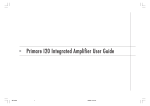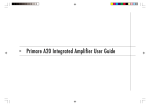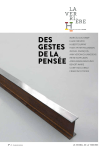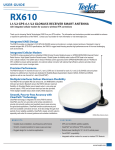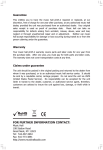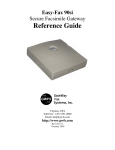Download KORA Electronic Concept Explorer 150SB User's manual
Transcript
KORA Electronic Concept Explorer 150SB Hybrid integrated amplifier User’s manual Kora E.C. 8 bis, rue Claude Perrault, 31000 Toulouse, France Web : www.kora.net - Email : [email protected] Table of Contents Page 1 Kora Electronic Concept - the Kora team Page 2 Read before use - voltage - installation - speakers - !!! Page 3 Operating instructions - connections - inputs - direct - monitor - turning on Page 4 Starting up - start procedure - turning off Audio/Video - phase Page 5 Trouble shooting Page 6 Technical specifications - guarantee Page 7 Front and rear schemas Page 1 Kora Electronic Concept You have just acquired a Kora Explorer 150SB integrated amplifier. We thank you for your confidence and wish you many hours of listening pleasure. Firstly, here are a few words about the company and the people behind Kora before you rush off to set up : Kora Electronic Concept was created in 1990 by a small team of electronics engineers working at the time for the Aero Spatial complex in Toulouse, south-west France. The transition from designing power supplies to producing Kora’s first hi-end tube amplifier, the Design 30, took four years of research. Since then we have produced many award-winning designs, ranging from the hybrid Explorer 90SI integrated to the Hermes D/A converter. The present Kora team is : François Philibert – Kora’s designer. Gérard Payrastre – R & D engineer/managing director. Cyril Canod – Production manager. Jeff Starrs – Communications and export sales. Brice Aboucaya – Sales, France. Alain De Stefani - Technician Page 2 Please read this before setting-up – it could save you a lot of trouble! Voltage Your Kora amplifier is workshop set from a fixed mains supply voltage. This voltage is marked on the rear plate of the unit. Before connecting, check that this voltage is the same as your mains supply. If you didn’t read this and your amp’s blown up, don’t say we didn’t warn you! Read on before turning on! Installation Please read carefully the complete instructions detailed here before installing the 150SB in your system. If you are already familiar with a system set-up, please make sure that you have connected your speakers, via speaker cable, to the output terminals of your 150SB before doing anything else – turning on a tube amplifier without a load connected can cause serious damage to your amplifier. If you decide on a enclosed location for your 150SB, make sure it is well ventilated. Speakers Connect your speakers to the speaker terminals on the rear plate of your amplifier. Red is positive and black negative. That’s red to red and black to black! The terminals take 4 or 8 ohm speakers and the connection can be made with either banana plugs or bare wire. Please read the next section before going on to page 3 – it’s not that authoritative! Don’ts ! Again, this is just to save you trouble! Don’t expose your amplifier to excessive cold, heat, sunlight, humidity or water - (e.g. the swimming pool is not a good place to leave it). Don’t use any chemicals when cleaning your amplifier (hydrochloric acid will eat it, for example). Just use a lightly dampened cloth. Don’t go messing around inside (the amplifier) without knowing what you’re doing (this could be very nasty). You can always ask your dealer or us if you need some help. Don’t forget to keep the original packing (it could increase in value over the years) – if you move, you’ll curse yourself for having thrown it out! Page 3 Connections - Source inputs Operating instructions So, now you can connect the different elements of your system (CD, tuner etc.) to the appropriate cinch (RCA) inputs at the rear of the amplifier. These are the source inputs – they are identical. Use high quality shielded cable in order to avoid ‘parasite noise’ and a weakening of the treble frequencies. The listening of the sound source is obtained by selecting the appropriate source. - Direct POWER IN allows you to attack the power section directly. Use the Direct button on front plate and/or the remote control handset. It is not affected by the volume control. You can connect, for example, an A/V processor (the volume control of the processor will then be active); a mixing desk or any other source that delivers 2V RMS and has a volume control. The PRE OUT output allows you to use the output of the preamplifier. The volume of the signal depends on the position of the potentiometer on the front plate. The gain of the preamp is graduated in decibels 0dB corresponds to a unitary gain. This output is permanently available and does not depend on the remote control handset. - Monitor This is a output/input loop for all types of recording systems. The signal on the monitor output is that of the input selected and does not pass by the preamp. The output of the recorder is connected to the input MONITOR IN. This input is independent of the other inputs and is validated by the MONITOR on the front plate or by the remote handset. Turning on Turning on : The main on/off switch is situated on the rear plate. Turn on the amplifier with this switch : the numbers indicating the gain will light up in blue on the front plate (8) ; the amplifier is in stand-by mode. With normal use, you don’t need to turn off with the rear plate switch; use the POWER button situated on the front plate. Never turn off the amplifier with the rear switch, nor disconnect the mains cable without having first turned off the unit with the POWER button as this can damage the power section. Page 4 - turning on The 150 has a motorised volume control that is controlled either by the front plate buttons or by the remote control handset. It is usable from the first time you turn on the unit as well as on stand-by mode. ADVICE : Regulate your amplifier around –40dB the first time you fire up, then adjust for your own taste. Press the POWER button : the blue LED above will blink for about 30 seconds. This is the necessary warm-up time for the tubes. During this period no other control is available. When the 30’ is over, the blue LED will remain alight and you’re ready to listen to music. The #1 input is automatically selected. To go into the stand-by mode, press the POWER button : the inputs cut out and the LED blue above the POWER button will blink for 30’. At the end of this period, only the volume/gain window will indicate that the unit is on standby mode. The energy used is inferior to 1w. You may leave the unit in this mode. Audio/Video - phase You may wish to use your 150SB in the context of an audio/video set-up. With the 150SB, as we’ve seen, it’s power section can be disassociated from the preamp section. You can then connect an A/V processor which will be driven by the 150SB preamp. When you have different amplifiers & speakers working together in a system, it’s very important to know the ‘phase’ of each of the amplifiers in order to obtain the optimum sound. For example, the 150SB, when working as an integrated, is in positive phase. However, when disassociated, the power section of the 150SB is in positive phase and the preamplifier of the 150SB in negative or inverse phase. Now, if your processor works in negative phase (ask your dealer!) with the power section of the 150SB in positive phase, you’ll need to inverse the red/positive & black/negative connections of the speakers on the processor – this way the phase will be positive and listening levels comfortable. One indication as to whether you have inverse phasing when you shouldn’t, is when you find you need a great amount of volume in order to hear properly. You’re probably ‘out of phase’ if this happens! Page 5 Trouble shooting CUT-OUT WHILE THE UNIT IS IN USE : Your Explorer 150 has a protection handled by the micro-processor. In the case of a problem with the power section (short-circuit/overload/etc), the fuses situated on the supply, cut out. This is then detected by the micro-processor that handles the 150, which then passes automatically onto the protection mode in less than a millisecond. At this moment, all the lights will shut down, including the gain numbers on the volume window. This signifies a fault in the unit : please contact your dealer or Kora directly. This may happen the first time you fire up the unit and is due to the fact that the supply is not yet loaded. The remedy is simply to turn off the unit by the switch on the rear plate, wait until the microprocessor has been reset and then turn on the unit again. If the problem persists, please contact your dealer. Technical specifications Page 6 EXPLORER 150SB Integrated hybrid amplifier Mains Consumption Fuse Power Frequency band Slew rate Inputs Signal/noise Dimensions Weight - guarantee 230V/50Hz (115V-USA) 500 watts max. 3A 2 x 100w @ 8 ohms 2 x 150w @ 4 ohms 0,2Hz @ 200Khz <1µ microseconds 330mV/1 M ohms (10Vcc max) 112dB 460 x 370 x 200mm 13kg Kora E.C. warrants to the original purchaser that this product shall be free from defects in material or workmanship for two (2) years from date of original purchase. Tubes : 90 days. Correct maintenance, repair and use are important to obtain performance from this product. Therefore, carefully read the User's Manual. This warranty does not apply to any defect that Kora E.C., in its sole discretion determines is due to : 1) Improper maintenance or repair, including installation of parts and accessories that do not conform to the quality and the specifications of the original parts. 2) Misuse, abuse, neglect or improper installation. 3) Accidental or incidental damage. During the warranty period, an authorized service facility will provide free of charge both parts and labor necessary to correct defects in material or workmanship. To obtain such warranty service, the original purchaser must include a dated proof of purchase from the dealer when returning the product, pre-paid, to the service center. Please contact your dealer for details. All repairs performed after the warranty period has expired will be billed to the owner and will carry a 90 day warranty on parts and labor. EXPLORER 150 SB functions – front/rear view Front plate 1. Power on/off selector. 2. Direct input selector. 3. Monitor selector 4. Inputs selector. 5. Increase output volume selector. 6. Decrease output volume selector. 7. Headphone socket. 8. Volume dial (in dB). Blue LED indicates selected source. Rear plate 1. 2. 3. 4. 5. 6. 7. Direct input to the power section. Direct output from the preamp section. Monitor input. Monitor output. Line inputs. Speaker sockets. Mains socket.










